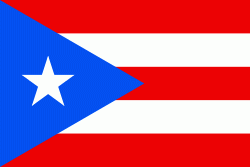San Germán (San Germán Municipio)
 |
 |
Puerto Rico was, at one time, divided administratively between the San Juan and the San Germán municipalities. The latter covered the western half of Puerto Rico and extended from the western shores of the island to Arecibo in the north and Ponce in the south.
The population of San Germán when Alonso Manso was named the first bishop of Puerto Rico in 1511 was "about 50 residents". Outside of San Juan, Puerto Rico, San Germán was one of the largest settlements in the 16th century, as well as Coamo and Aguada.
San Germán is also known as the "founder of towns", given the fact that in 1514 the Spanish Crown separated the island into two administrative territories (Partidos). The borders of the two partidos were established as the Camuy River to the north and the Jacagua River to the south. They were named the San Juan Partition and the San Germán Partition.
Spanish settlement in San Germán occurred early in the conquest and colonization of Puerto Rico. After the destruction of a small early settlement near modern-day Añasco during a Taíno uprising which started in February 1511, in 1512 the new settlement was built by Miguel Díaz at Guayanilla and was named after Germaine of Foix, the second wife of King Fernando II, and in reference of Saint Germanus of Auxerre. This town was attacked by French corsairs in August 1528, May 1538 and 1554. The construction of a small fort began in 1540, but work stopped in 1546 when the population of the town began moving inland to the current modern location.
On May 12, 1571, the Royal Audience (Real Audiencia) of Santo Domingo authorized that both the populations of San Germán and Santa María de Guadianilla be merged into a single city due to the constant French attacks. The new city was built on the Hills of Santa Marta, next to the Guanajibo River in 1573. Its official name was Nueva Villa de Salamanca, named after the city of Salamanca in Spain. However, the population called the city San Germán el Nuevo (New San Germán) and, eventually, the Villa de San Germán (City of San Germán).
San Germán is also known as the "founder of towns", given the fact that in 1514 the Spanish Crown separated the island into two administrative territories (Partidos). The borders of the two partidos were established as the Camuy River to the north and the Jacagua River to the south. They were named the San Juan Partition and the San Germán Partition.
Hurricane Maria on September 20, 2017 triggered numerous landslides in San Germán with the significant amount of rainfall.
Map - San Germán (San Germán Municipio)
Map
Country - Puerto Rico
 |
 |
Currency / Language
| ISO | Currency | Symbol | Significant figures |
|---|---|---|---|
| USD | United States dollar | $ | 2 |
| ISO | Language |
|---|---|
| EN | English language |
| ES | Spanish language |















